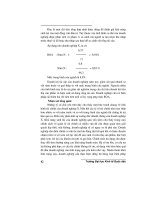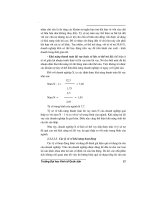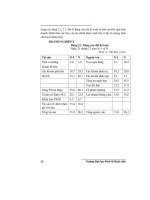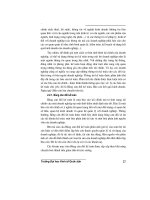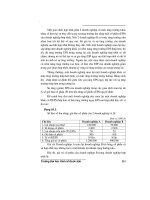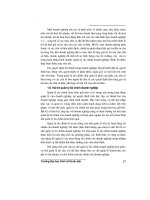PHAN TICH VAI TRO của TAI CHINH DOANH NGHIỆP DANH GIA VAI TRO của CFO TRONG DN ở GIAI DOẠN KINH tế HIỆN NAY e
Bạn đang xem bản rút gọn của tài liệu. Xem và tải ngay bản đầy đủ của tài liệu tại đây (97.96 KB, 16 trang )
PHAN TICH VAI TRO CỦA TAI CHINH DOANH NGHIỆP. DANH
GIA VAI TRO CỦA CFO TRONG DN Ở GIAI DOẠN KINH TẾ HIỆN NAY
TABLE OF CONTENT
TABLE OF CONTENT................................................................................................2
RESEARCH OF CONTENT........................................................................................3
PART 1: FOREWORD..................................................................................................3
1. Role of corporate finance..........................................................................................3
1.1 Corporate Finance guarantee mobilization of capital for business operations as
normal and continuous..................................................................................................3
1.2 Corporate Finance plays an important role in improving the business performance
of enterprises.................................................................................................................3
1.3 Corporate Finance is a very useful tool to control the business situation of
enterprises..................................................................................................................... 4
2. Goal of corporate finance..........................................................................................4
2.1 Selection and investment decisions.........................................................................4
2.2 Determining capital needs and capital raising organizations respond promptly and
fully to the capital needs of the business activities........................................................5
2.3 Use effective is the capital, strict management of revenues and expenditures and
ensure the solvency of the business...............................................................................5
2.4 Implementation of profit distribution, appropriation and use of corporate funds....5
2.5 Regular control the operations of the business........................................................5
2.6 Implement the financial planning............................................................................6
3. Role of the CFO (chief financial officer) in the enterprise........................................6
4. The need of titles CFO (chief financial officer) of businesses in Vietnam................7
PART 2: TEST..............................................................................................................9
LIST OF REFERENCES............................................................................................17
1
RESEARCH OF CONTENT
PART 1: FOREWORD
1. Role of corporate finance
Business is an economic organization has its own name, assets-based
transactions and stable business registered under the provisions of law for the purpose
of implementing the business - ie make a, some or all stages of the investment
process, from production to sale of products or provision of services on the market for
the purpose of profit. Corporate Finance is understood as the relationship between
business value to stakeholders in the economy.
Corporate Finance plays a very important role for the operation of the business
and is expressed in the following main points:
1.1 Corporate Finance guarantee mobilization of capital for business operations as
normal and continuous.
Monetary capital is a prerequisite for the operation of the business. In the
course of business activity generally raises short-term needs and long-term capital for
business operations as well as for regular investment in the development of the
business. The lack of funds will make the operation of the business difficult or not
implemented. Therefore, to ensure that the operation of the business is conducted
normally, constantly depend greatly on the organization's funding business finance.
The success or failure of the business activities of enterprises in large part be
determined by the funding policy of raising capital or business.
1.2 Corporate Finance plays an important role in improving the business
performance of enterprises.
This role of corporate finance is shown in that: The decision-making right
investment depends largely on the evaluation and selection of investment from a
financial perspective. Raising capital in time to help enterprises fully business
opportunities seized. Selection of form and methods appropriate to mobilize capital
can reduce the cost of capital contributed greatly increase the profitability of the
business. Using leverage business and especially financial leverage is reasonable
factors significantly increase margin equity. Mobilizing the maximum amount of
capital available to business operations can avoid damage due to capital accumulation,
2
increased asset turnover, reducing the number of loans that reduce interest payments,
contributed greatly increased interest Net profit of the business.
1.3 Corporate Finance is a very useful tool to control the business situation of
enterprises.
Business processes of the enterprise as well as the process of mobilization and
morphological transformation of monetary capital. Through the collection and
spending money every day, the situation of the financial indicators and especially the
financial statements can control time and overall operational aspects of the business,
from which quickly out of existence and the untapped potential to make the
appropriate decisions to adjust activities to achieve goals of the enterprise. In the
market economy, the role of corporate finance is becoming more and more important
for the operation of the business. Because of these reasons below:
- The financial activities of enterprises involved and affect all business
activities.
- Scale of the business and operational needs of capital for growing businesses.
On the other hand, the financial market is growing rapidly, the financial instruments to
raise capital more abundant and diverse. Therefore, capital mobilization decisions,
investment decisions, etc,... to the growing influence of the situation and the business
performance of enterprises.
- The information about the financial situation is important base for business
managers to control and direct the activities of the business.
2. Goal of corporate finance
2.1 Selection and investment decisions
The prospect of a future business depends heavily on investment decisions for
large-scale long-term investment decisions as technological innovation, business
expansion, new product manufacturing,etc... To go to investment decisions requires
businesses to consider many aspects to consider on economic, technical and financial.
In particular, the financial consideration to capital expenditures for investments and
investment income by bringing back. In other words, considering the cash flow and
the cash flow related to investments to assess investment opportunities financially. It
is the process of planning a budget estimate and evaluate the financial performance of
the investment.
3
2.2 Determining capital needs and capital raising organizations respond promptly
and fully to the capital needs of the business activities.
All the activities of businesses require capital. Corporate Finance to determine
the capital requirements necessary for the operation of the business during the period
(which implies long-term and short-term capital). Next, the organization must raise
capital to meet the timely, complete and beneficial to the operation of the business. To
go to decide the form and method of raising capital appropriate, consideration should
weigh on many aspects such as structural funds, the advantages of each form of
capital raising costs for the use of each capital,etc,...
2.3 Use effective is the capital, strict management of revenues and expenditures and
ensure the solvency of the business.
Corporate Finance to find ways and means to mobilize the maximum amount
of capital available to the business of business, freeing up the capital accumulation,
closely monitoring and effective implementation of payment and withdrawal of
money sales and other revenues, and closely managing all expenses incurred in the
course of business operations. Constantly seek measures to establish a balance
between revenue and expenditure in cash, ensuring that businesses always have the
ability to pay due debts.
2.4 Implementation of profit distribution, appropriation and use of corporate funds.
Make a reasonable distribution of profit after tax, as well as setting up and
using the funds of the enterprise good will contribute significantly to the development
of enterprises, improve living standards and morale of the employees in the business
career.
2.5 Regular control the operations of the business.
Through the collection and spending money every day, the financial statements,
the implementation of the financial indicators for monitoring the operational status of
the business. On the other hand, need to conduct periodic analysis of the financial
situation of enterprises. Through analysis, to assess the efficiency of capital use,
strengths and weaknesses in management and predict the financial situation of
enterprises. From there to help leaders manage the business, making timely decisions
appropriate to adjust business operations and finance. Thus, corporate finance is
considered to be one of the important tools to manage the business.
4
2.6 Implement the financial planning
The financial operations of enterprises should be scheduled in advance through
financial planning. There is good financial planning, enterprises can make appropriate
financial decisions to achieve business goals. The process of implementation of the
financial plan is also actively processes offer effective solutions to market
fluctuations.
3. Role of the CFO (chief financial officer) in the enterprise
The chief financial officer (CFO), who manage the cash flow of the business,
an important factor especially in the period of global economic crisis today. As the
blood vessels nourishing the body, the currency of the business to run continuously.
But to run in any direction, the speed of stars, big or small ... traffic is greatly
dependent on the decision of the chief financial officer.
With the functions of financial management, the CFO should always closely
monitor the path of the money flow, generate matrix rational, efficient use of capital.
At the same time, the CFO must also skills training "steering the ship" can control the
flow with different speeds on each boat ramp to the quickest possible lapse safely.
To make this possible, the CFO should understand not only the importance of
knowledge, training and skills required but also the tools needed to be sensitive
analysis, judgment, given the proper orientation case. They have turned the
"Accounting Information System" to "Financial Information System" to analyze and
handle financial relationships in business, building financial plans, exploitation and
use effective capital and risk warning for businesses, offering a reliable prediction of
the future.
The role of the CFO is expressed as a bridge between the financial markets
now. That role is expressed as follows:
(1) First, the CFO will hold raising capital to meet the capital needs for
production and business activities of enterprises. Thus, CFO will have to forecast
capital needs and choices necessary forms to mobilize capital with reasonable scale.
(2) After raising capital, financial director will perform the allocation of capital
for the investment opportunities of the business. In conditions of limited funding,
CFO must allocate capital for investment projects that can maximize the benefits for
owners.
5
(3) The investment and efficient use of assets with high efficiency will bring
incremental cash flow for the business.
(4) Finally, CFO will have to decide the distribution of cash flow from
operations of the business. The cash flow that can be reinvested back now or
reimburse investors.
Through the above analysis, we can see the CFO of a business can have an
important role through the analysis and the choice of three fiscal policy strategy,
namely:
+ Enterprise should invest in the project in terms of financial resources is
limited to maximize the benefit of the owners? Answer this question ie selection
policy has optimal capital investment.
+ Enterprise should finance investment projects with public funding to scale
how much? Answer this question means selected financing policy optimization.
+ Distributed enterprise should operate business results like? The selection of
the answer to this question is chose the profit distribution policy (dividend policy)
optimization. These policies will have an impact on the growth rate of income of the
owner in the future and the impact it will increase or decrease the value of the
company on the market.
4. The need of titles CFO (chief financial officer) of businesses in Vietnam.
In the context of economic difficulties at present, the role of the CFO is very
important, it is who will advise on strategies for the Board of Directors based on the
financial situation of the company and cash flow forecasts.
During these tough business, and many business leaders have chosen to
"polish" or "falsified" the financial data, through accounting techniques of finance
director. So, in this context, many CFO have to stand in front of two choices, one's
personal morality and community interests, the interests of the two businesses. In
many cases, to protect the enterprise, the chief financial officer to accept the wrong
way, but they are suffering with this center.
Also, follow me, in Vietnam the concept CFO was new, and most of the
companies in Vietnam, chief financial officer or chief accountants have the same role,
but in fact, CFO is to advise the board in business strategy and take responsibility for
6
their financial strategies proposed, only the chief accountant manage the financial
situation of the company.
During this time the director of finance need to change, enhance his role, not
only as managers of profit and loss numbers of businesses, which have seen
circulation of cash flow , and how to reduce the financial cost to businesses overcome
difficulties.
The most difficult of the CFO, not just the current business not easily acquire
bad debts, or the inability to pay quickly, which is not a recognized leadership role in
advising the them. While, in many cases the projects have been implemented but the
board did not calculate all the scenarios, the feasibility away,etc,... Which sometimes
lead to cash flow managed to keep the project stalled, wasteful enterprise, and the
enterprise led to the bankruptcy or dissolution.
When the board has decided to invest, borrow, nobody consulted CFO but
when problems occur or female doubtful debts liquidity is now chief financial officer
shall be responsible for handling the reason, it is paradoxical in many companies
today. I think it must have another look at the CFO, based on the financial
administration to set out the policy, strategy, corporate moves, in the debt structure,
financial problems in investment projects, not only as they are the record numbers
took place.
Yourself when choosing investment funds financed company is interested to
see the company's chief financial officer or not. So often in the company's CFO,
financial management professional. In fact, many companies are only interested in
producing, not interested in the big issues such as cash flow, strategic financial risk
management, this is very dangerous for the survival of the business, so the investment
is also considered as capital here.
7
PART 2: TEST
Please choose the most correct answer by circling on the correct answer that
you have selected. Template questions have only one correct answer.
INFORMATION BELOW (TABLE 1) USED FOR ANSWERS FROM
QUESTION 1 TO QUESTION 5
Balance Sheet of the Smith Company
Assets:
Cash and securities marketable
Receivables
Inventories
Prepaid expenses
Total Current Assets
Fixed assets
Except: accumulated depreciation
Net fixed assets
Total Assets
Liabilities:
Short-term payables
Negotiable instrument payables
Tax accrual
Total current liabilities
Long-term debt
Equity
Total Long-term debt and Equity
$300.000
2.215.000
1.837.500
24,000
$3.286.500
2.700.000
1.087.500
$1.612.500
$4.899.000
$240.000
825.000
42.500
$1.107.000
975.000
2.817.000
$4.899.000
8
Income Statement
Net sales (sell on credit)
Except: Cost of goods sold
Selling expenses & General
$6.375.000
4.312.500
administration
expenses
Depreciation expense
Interest expense
Income before tax
Corporate income tax
Income (profit) net
Common stock dividends
Income (profit) leave
1. Based on the information in Table 1, the current rate is:
A.
2,97
B.
1,46.
C.
2,11.
D.
2,23.
1.387.500
135.000
127.000
$412.500
225.000
$187.500
$97.500
$90.000
2. Based on the information in Table 1, using 360 days / year average collecting
money period:
A.
71 days
B.
84 days
C.
64 days
D.
125 days
3. Based on the information in Table 1, the debt ratio (ratio of liabilities) is:
A.
0,70.
B.
0,20.
C.
0,74.
D.
0,42.
4. Based on the information in Table 1, the net profit margin on sales equal how
much:
A.
4,61%.
B.
2,94%.
C.
1,97%.
D.
5,33%.
5. Based on the information in Table 1, the Inventory Turnover Ratio is:
9
A.
0,29 times
B.
2,35 times
C.
0,43 times
D.
3,47 times
6. Which is type the following companiesno subjectload limited liability debt?
A)
Private Company
B)
Joint Stock Company
C)
Public company
D)
All the above answers are wrong
7. Calculate the present value (PV) of $ 100,000 received after 5 years from
today, assuming an interest rate of 8% / year?
A)
$60.000,00
B)
$68.058,32
C)
$73.502,99
D)
$82.609,42
8. Calculate the present value (PV) of $ 80,000 received after 10 years from
today, assuming an interest rate of 5% / year?
A)
$38.422,76
B)
$40.000,00
C)
$49.113,06
D)
$76.000,00
9. Calculate the present value (PV) of $ 50,000 received after 20 years from
today, assuming an interest rate of 4% / year?
A)
$5.242,88
B)
$10.000,00
C)
$22. 819,35
D)
$40.000,00
10. Calculate future value (FV) of $ 60,000 in 5 years, assuming the interest
rate is 5% / year?
A)
$62.500,00
B)
$72.674,86
C)
$75.000,00
10
D)
$76.576,89
11. The NPV method:
A.
Is consistent with the goal of maximizing value for shareholders.
B.
Recognizing the value of money over time.
C.
Use cash flow
D.
All the above answers are correct
12. The NPV method assumes cash flows are reinvested at the:
A.
IRR.
B.
NPV.
C.
The rate of real income.
D.
Weighted Average Cost of Capital (WACC)
13. You are analyzing a proposed project and have the following information:
Year
Cash flow
0
-$135.000
1
$ 28.600
2
$ 65.500
3
$ 71.900
Payback period required
3 years
Income ratio requirements
8,50%
Net Present Value (NPV) of the proposed project is ?
A.
$3.289,86
B.
$3.313,29
C.
$4.289,06
D.
$4.713,71
14. Calculate future value (FV) of $ 10,000 in 8 years, assuming an interest rate
of 10% / year?
A)
$16.212,78
B)
$18.000,00
C)
$18.756,22
D)
$21.435,89
15. Calculate future value (FV) of $ 20,000 in 4 years, assuming an interest rate
of 12% / year?
11
A)
$17.096,08
B)
$28.292,66
C)
$31.470,39
D)
$32.020,64
16. If $ 15,000 is invested at interest rate of 10% / year, asked how long will
the investment be doubled?
A)
7,3 years
B)
8,4 years
C)
10,6 years
D)
14,8 years
17. If the money is invested at 8% interest rate / year, asked approximately how
many years the interest received will be equal to the original investment?
A)
5 years
B)
6 years
C)
9 years
D)
12 years
18. Sara wants to have $ 500,000 in a savings account when she retired. Ask
how much she must have money in the account now if the interest rate is fixed at 8% /
year, to make sure she will have $ 500,000 in 20 years?
A)
$107.274
B)
$144.616
C)
$180.884
D)
$231.480
19. You are analyzing a proposed project and have the following information:
Payback period required
Income ratio requirements
Year
Cash Flow
0
-$135.000
1
$ 28.600
2
$ 65.500
3
$ 71.900
3 years
8,50%
The payback period using discounted cash flow of the project?
12
A.
2,57 years
B.
2,64 years
C.
2,87 years
D.
2,94 years
20. Which of the following is not considered as equity in the balance sheet of
the company?
A.
Cash
B.
Paid in capital
C.
Preferred shares
D.
Income leave (profit retention)
E.
Ordinary shares
21. Calculated Yield To Maturity (YTM) of a 5-year bonds, $ 5,000 par value
bond with a 4.5% interest rate and pay interest every 6 months if coupon bond is
priced at $ 4876?
A)
4.30%
B)
5.07%
C)
6.30%
D)
8.60%
22. Calculated Yield To Maturity (YTM) of a 10-year bonds, $ 1,000 par value
bond with a 5.2 % interest rate and pay interest every 6 months if coupon bond is
priced at $ 884?
A)
5.02%
B)
6.23%
C)
6.82%
D)
12.46%
23. A bond have 3-year term, Par value of $ 2,000 and have 6.3% interest rate
bonds with coupon rate paid annually (1 year payment 1 times). Ask Yield To
Maturity (YTM) by how much if the bond is priced $ 1,801?
A)
6.30%
B)
8.48%
C)
9.22%
D)
10.32%
13
24. /One bonds par value $ 1,000 bond with an interest rate of 5.4% / year and
coupon interest paid every 6 months, bonds have 5 year term and Yield To Maturity
(YTM) of 7.5%. If interest rates rise and Yield To Maturity - YTM rise 7.8%, How are
bond prices affected ?
A)
Decrease $9,82
B)
Decrease $11,59
C)
Increase $12,16
D)
The price of the bond does not change.
25. One bonds par value $ 5,000 bond with an interest rate of 6.4% / year and
coupon interest paid every 6 months, bonds have 4 year term and Yield To Maturity
(YTM) of 6.2 %. If interest rates rise and Yield To Maturity - YTM rise 0.8%, How
are bond prices affected ?
A)
Decrease $98,64
B)
Increase $40,49
C)
Increase $84,46
D)
Increase $142,78
26. Calculated bond yields of bonds with a term of 2 years, $ 10,000 par value
of the coupon interest paid every 6 months and the current price of the bond is $
9,543.45, Yield To Maturity (YTM) 6.8%?
A)
4,32%
B)
5,60%
C)
6,25%
D)
8,44%
27. In Harry's birth, his father spent on $ 1,000 investment account committed
paying interest of 4% / year. Asked how much money Harry would be have when he is
18 years old?
A)
$1.720
B)
$2.026
C)
$2.804
D)
$4.806
14
28) Helen's savings to start her business. If she invested $ 10,000 in the account
now, asked how much of the minimum interest rate is to make sure that she has $
25,000 in her account in 10 years?
A)
2,5%
B)
6,4%
C)
9,6%
D)
10,2%
29. Consider the following chain of cash flows:
0
1
2
3
4
|
|
|
|
|
?
$5000
$6000
$7000
$8000
Year
Cash
Flow
If the market interest rate at 8% / year, the present value (PV) of the cash flow
chain will be approximately:
A)
$22.871
B)
$21.211
C)
$24.074
D)
$26.000
30. Consider the following chain of cash flows:
0
1
2
3
4
|
|
|
|
|
$1000
$2000
$3000
$4000
?
Year
Cash
Flow
If the market interest rate at 8% / year, the present value (PV) of the cash flow
chain will be approximately:
A)
$11,699
B)
$10,832
C)
$12,635
D)
$10,339
15
LIST OF REFERENCES
1) Curriculum Course in Corporate Finance, Associate Professor, Dr. Nguyen
Huu Anh, 2014.
2) Financial Management business, Do Mai Thom, 2014.
3) Financial Management, Phung Manh Lan, 2013.
4) CFO Handbook, Nguyen Huu Toan, 2013.
5) The director of financial instruments, Vo Thanh Ha, 2013.
16


